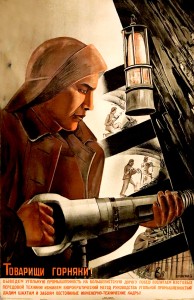Kulagina, Valentina Nikiforovna
Born 1902, Klinskii District, Moscow Region, Russian Empire; Died December 14, 1987, Moscow, USSR
Valentina Nikiforovna Kulagina was a Soviet graphic artist. Her husband was Gustav Klutsis, the foremost designer of Soviet photomontage. While Kulagina’s contribution to graphic design was often achieved through the collaboration with her husband, she too had a remarkable career in the field of book and magazine graphics, posters and photomontage. The couple routinely had their designs published by Gosizdat (State Publishing House), and the posters and projects they created are now considered iconographic testimonials of Soviet imagery.
After moving from the outskirts northwest of Moscow, in 1919 Valentina Kulagina embarked on her artistic education at the State Free Art Studios (SVOMAS) in Moscow. From 1920 to ‘21, she continued her studies there after it became VKhUTEMAS (Higher Art and Technical Studios). While an art student, she met Klutsis and the two married in 1921. The couple lived in the school with other artists such as Aleksandr Rodchenko, Vera Stepanova, and Sergei Senkin, all contributors to Soviet design. Initially dropping out of VKhUTEMAS, Kulagina graduated from the school in 1929. Her thesis design was purchased by Gosizdat.
Kulagina’s first professional exhibition of photomontage design occurred in 1925. In 1928, she participated in the decoration of the Soviet pavilion at the International Press Exhibition (“Pressa”) in Cologne, Germany. In addition, she worked as a designer for VOKS (All-Union Society for Foreign Cultural Ties). Kulagina became a member of the Oktiabr' (October) artists group in 1928 and exhibited at their exhibition in Moscow in 1930. In 1931 she participated in the photomontage retrospective at the Kunstgewerbemuseum in Berlin, and in 1932, she exhibited at the Moscow exhibition, Posters in the Service of the Five-Year Plan. She was responsible for the photomontage devoted to Siberia that was mounted in the Soviet pavilion of the 1937 Paris International Exhibition.
Following the January 1938 arrest and subsequent death of her husband, Valentina Kulagina nearly abandoned her artistic career. However, as a single mother she was obligated to forge-on with sporadic work as a means of financial support. One such as the commission she obtained was the decoration of murals for pavilions at the All-Union Agricultural Exhibition in Moscow. After World War II, Kulagina worked as an independent designer on occasional projects but the apex of her fame had passed.
Sources & Citations
Tupitsyn, M. (2004). Gustav Klutsis and Valentina Kulagina: Photography and montage after constructivism. Gottingen: Steidl. (Book on the life and work of Klutsis and Kulagina)
Stedelijk Museum. (1993). Vellikia utopia: Russkii i sovetskii avangard 1915-1932. [Exhibition catalog]. Bern, Switzerland: Benteli Verlag.
Sotheby's Gallery. (1994). USSR in Contstruction: Posters, Designs and Drawings. [Auction catalog]. New York: Sotheby's, Inc. (p. 159, Kulagina poster cited)
monoskop.org/Valentina_Kulagina
mcbcollection.com/valentina-kulagina
rusavangard.ru (place of birth and date, place of death)
